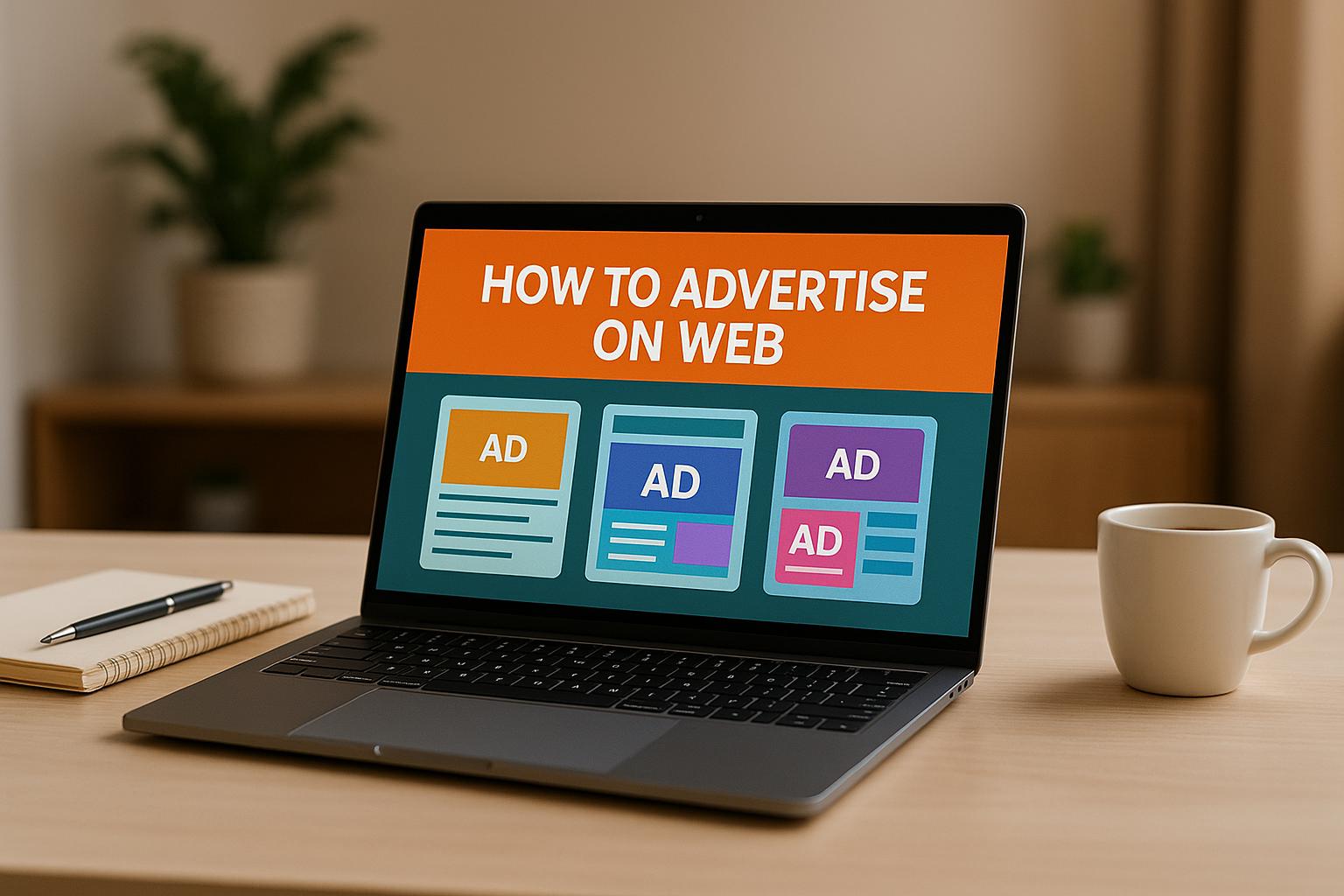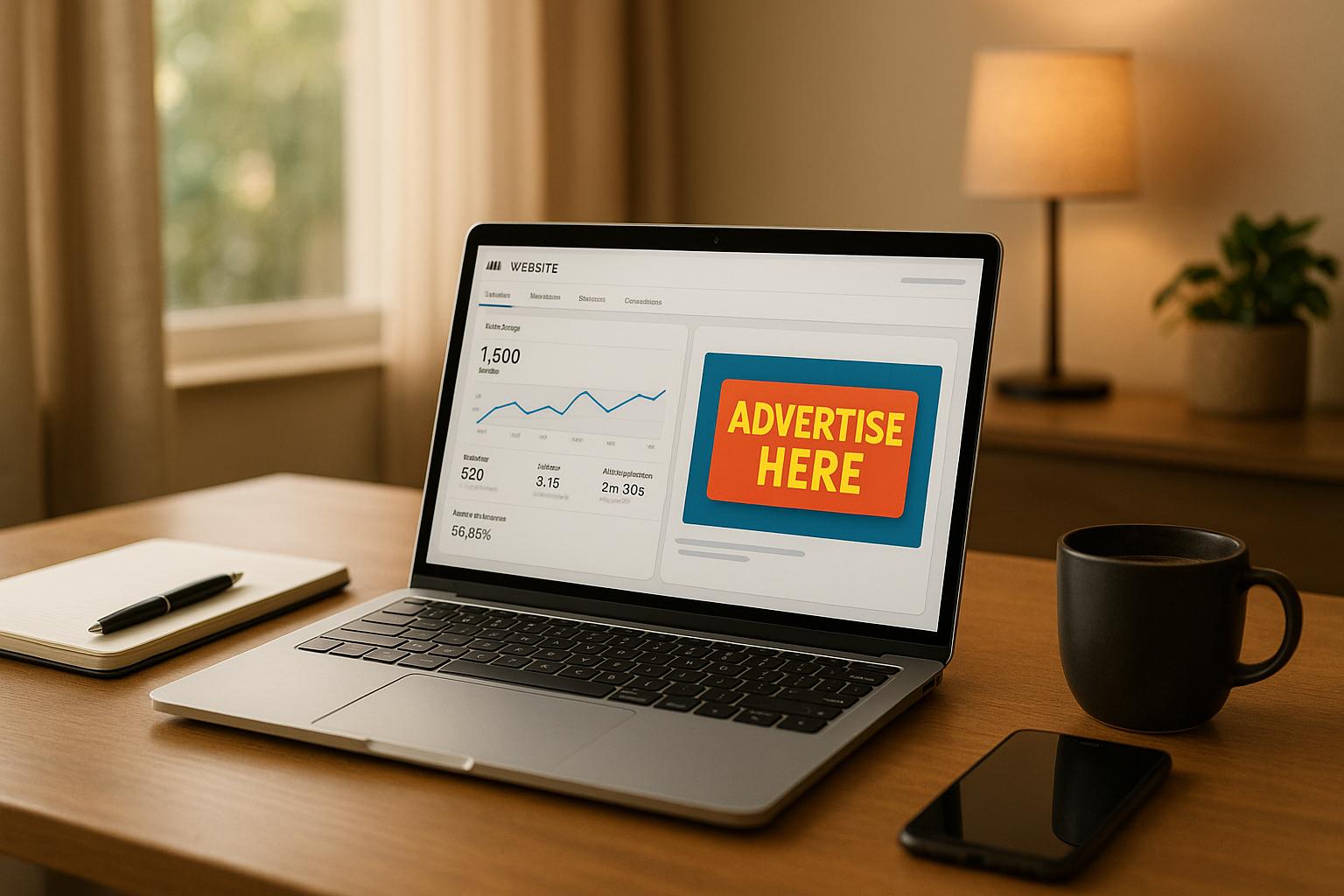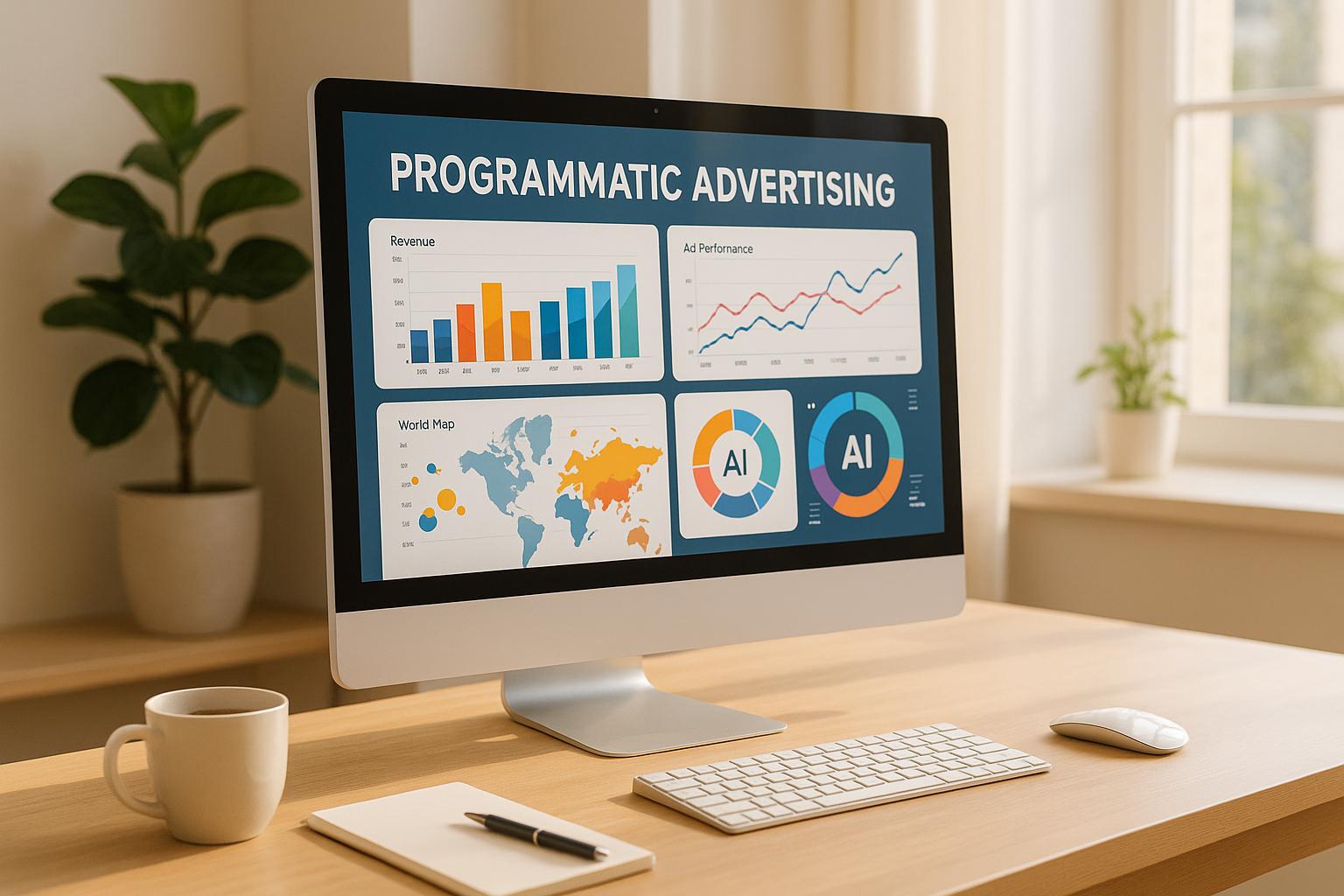AdSense remains a popular choice for publishers, but in 2025, it's no longer the only - or best - option. Platforms like TinyAdz, Ezoic, Mediavine, and Media.net offer alternatives that cater to specific needs, from small publishers to high-traffic sites. Here's a quick breakdown:
- AdSense: Easy setup, 68% revenue share, $100 minimum payout, but limited support and high account suspension risks.
- TinyAdz: No traffic requirements, personalized ad matching, and diverse monetization options like social media and newsletters.
- Ezoic: AI-driven optimization, no traffic minimum, 90% revenue share (after fees), and a $20 payout threshold.
- Mediavine: Premium option for sites with 50,000+ sessions, offers higher RPMs and excellent ad quality.
- Media.net: Focuses on tier-1 traffic with CPMs up to $5.00, requires quality content and is invite-only.
Quick Comparison
| Platform | Traffic Requirement | Revenue Share | Minimum Payout | Payment Term | Best For |
|---|---|---|---|---|---|
| AdSense | None | 68% (display ads) | $100 | NET 30 | Beginners, small publishers |
| TinyAdz | None | Not disclosed | Not disclosed | Not disclosed | Niche publishers |
| Ezoic | None | 90% (after 10% fee) | $20 | NET 30 | AI optimization seekers |
| Mediavine | 50K sessions/month | 75%-80% | $25 | NET 65 | Established content creators |
| Media.net | Tier-1 traffic (invite-only) | Not disclosed | $100 (PayPal) | NET 30 | Tier-1 traffic publishers |
If you're just starting out, platforms like AdSense or Ezoic are great entry points. As your traffic grows, consider premium options like Mediavine or Media.net for better revenue potential. Diversifying your monetization strategy is key to staying competitive in the evolving digital advertising landscape.
12 Highest Paying Adsense Alternatives in 2024
1. TinyAdz
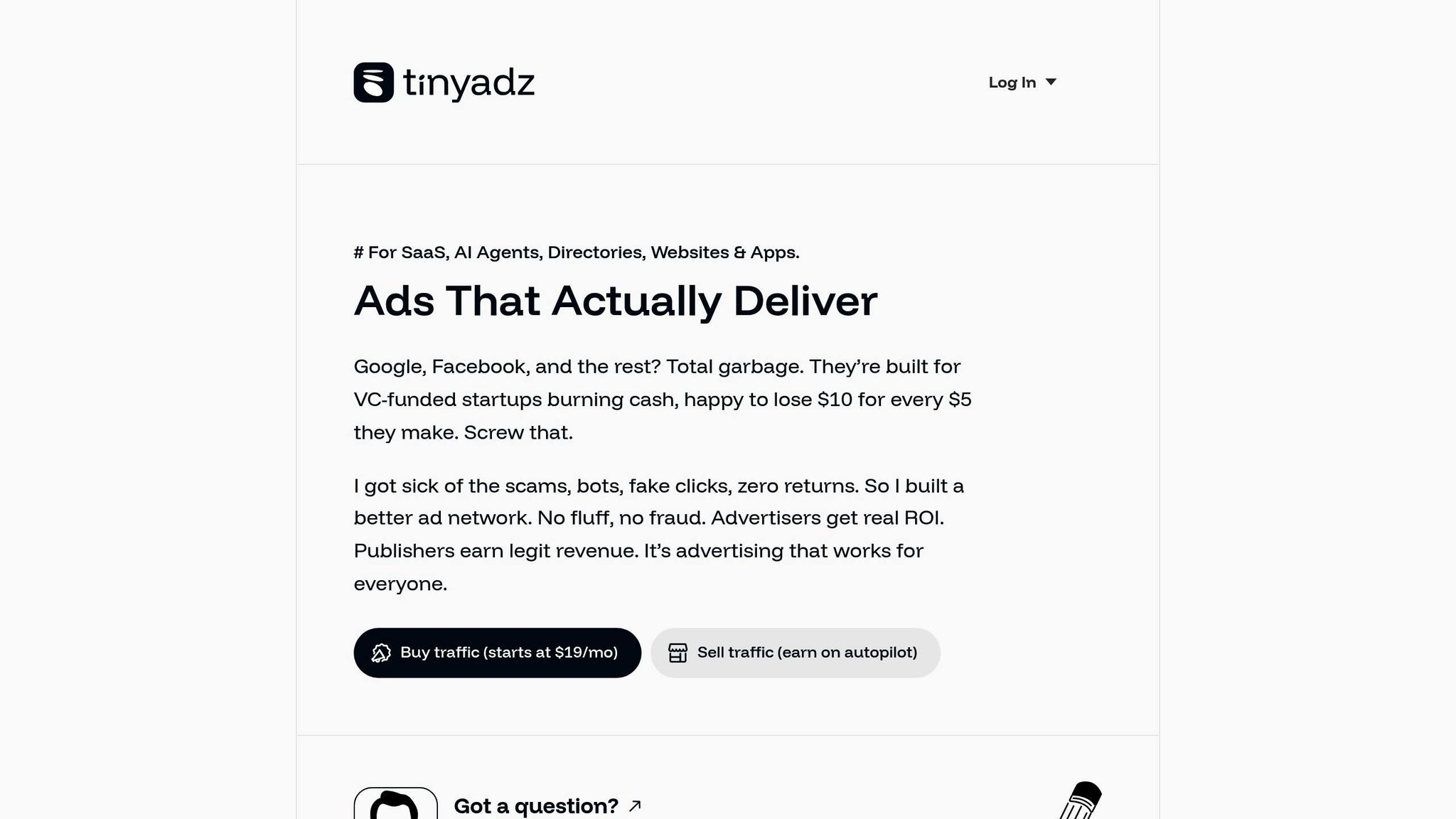
TinyAdz is designed for niche publishers and smaller websites that often get overlooked by larger ad networks. Its main focus is connecting advertisers with highly engaged audiences on these smaller platforms, creating opportunities for both sides to benefit from targeted advertising efforts.
Revenue Potential
TinyAdz operates on a hyper-targeted advertising model, matching advertisers with specific niche audiences to drive higher conversion rates and revenue. One standout feature is its commitment to delivering 100% human impressions, eliminating bots and fake traffic. This approach builds trust with advertisers while giving publishers the flexibility to select ad formats and campaigns that best fit their content and audience.
Traffic Requirements
Here’s a big win for newer publishers: TinyAdz doesn’t require a minimum traffic threshold. This means even small or highly specialized websites can start monetizing their platforms right away.
Payout Structure
While TinyAdz doesn’t disclose its exact payout percentages, it makes up for this with clear and detailed performance metrics. Publishers can easily track how their content is generating revenue, ensuring transparency in the process.
Platform Features
TinyAdz goes beyond traditional banner ads with a variety of monetization options. Publishers can earn revenue through:
- Directories: Turn existing directories into income streams.
- Social Media: Monetize engaged followers on platforms like Instagram or Twitter.
- Newsletters: Create dedicated revenue streams from email campaigns.
- Events: Unlock additional earnings during live or virtual events.
One of the platform’s standout features is its personalized matchmaking system. It pairs publishers with advertisers in a way that ensures ads feel natural and relevant to the audience, creating a seamless experience. This thoughtful approach helps both publishers and advertisers see measurable results from their efforts.
Next, let’s take a closer look at how Google AdSense stacks up in these areas.
2. Google AdSense
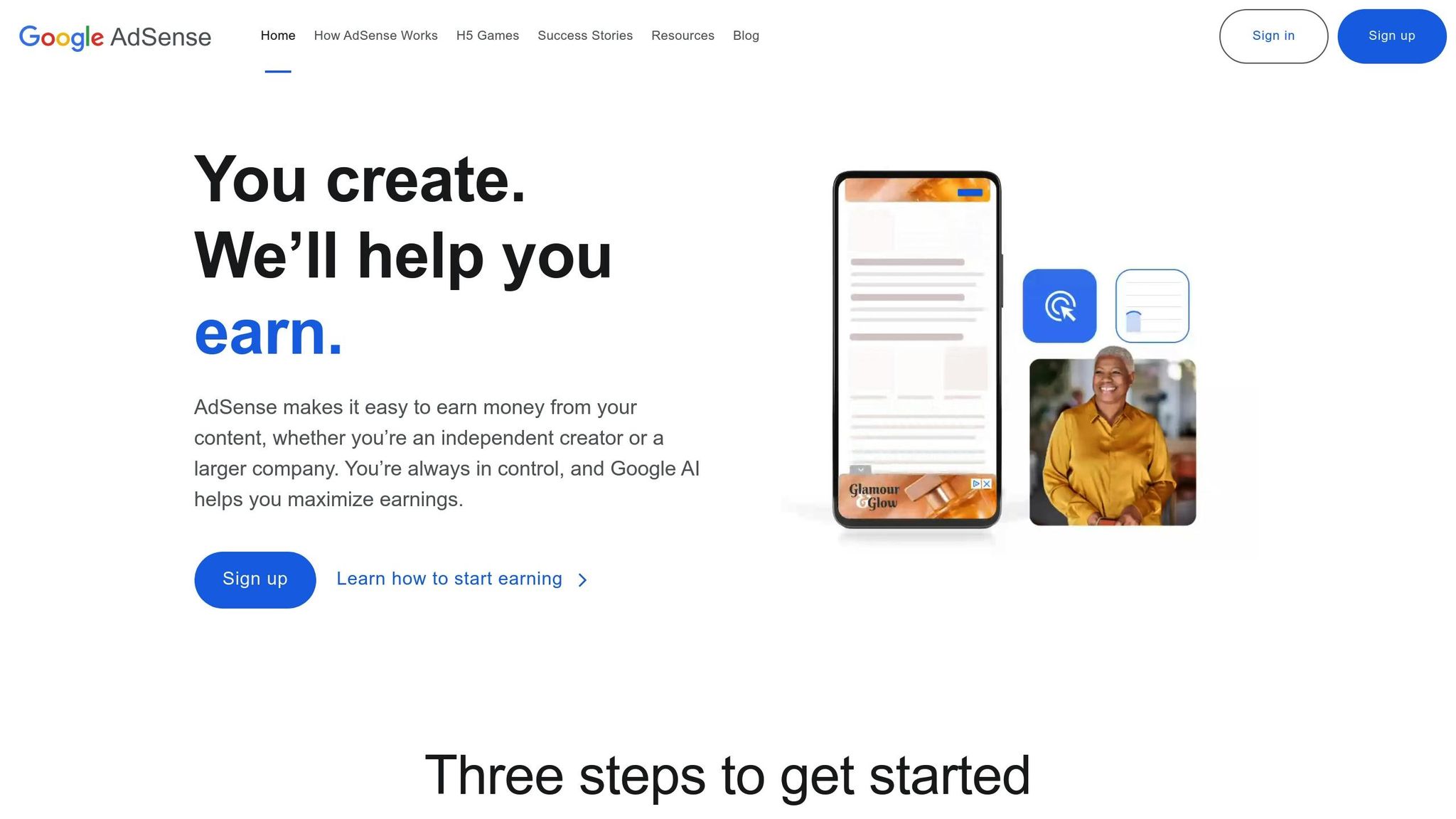
Google AdSense supports monetization efforts for over 40 million websites globally. As a widely recognized platform, it provides an accessible way for publishers to earn from their content.
Revenue Potential
AdSense earnings vary based on factors like niche and audience demographics. For example, finance websites often generate the highest returns, with revenue per thousand impressions (RPM) ranging from $30 to $50. High-value niches also see impressive cost-per-click (CPC) rates - for instance, insurance ads average $19.87 per click, online education ads hover around $10.74, and online banking ads bring in about $10.50.
In the U.S., CPCs typically range from $0.45 to $0.61, while RPMs fall between $4.59 and $6.15. Top-performing sites can earn anywhere from $1,000 to $50,000 per month, depending on their traffic volume and how well they optimize their ad strategy.
A notable change occurred in February 2024 when Google transitioned to an impression-based eCPM model, which further highlights how traffic levels directly impact revenue.
Traffic Requirements
While AdSense doesn’t enforce a strict traffic minimum, having at least 100 unique visitors per day is a good starting point. Google places a strong emphasis on the quality of your website’s content during the application process. This means even lower-traffic sites can get approved if they provide original, engaging, and policy-compliant content.
To understand potential earnings, consider this: generating $100 per day often requires around 10,000 daily pageviews. For monthly earnings of $100–$200, you’d typically need 20,000 to 40,000 pageviews.
Payout Structure
AdSense operates on a revenue-sharing model where publishers keep 80% of the earnings. Payments are issued monthly, with a minimum payout threshold of $100 for U.S. publishers. Earnings from the previous month are deposited directly between the 21st and 26th.
The platform uses an auction system where advertisers bid for ad space. The winning bid, factoring in ad quality, determines which ad is displayed. On average, CPC rates hover around $2.32.
Platform Features
AdSense provides a variety of ad formats to suit different types of content, including display ads, in-feed ads, in-article ads, multiplex ads, and search engine ads. These options allow publishers to align their ad strategy with their audience and content style.
Where you place ads matters - a lot. Ads positioned above the fold can generate 1.5 to 2 times more revenue than those placed below the fold. Additionally, video ads tend to outperform standard display ads, and optimizing for mobile is essential since Google prioritizes mobile-friendly sites.
AdSense is particularly well-suited for smaller publishers with fewer than 100,000 monthly visitors. However, for websites with significant traffic, other platforms might be more lucrative, with some claiming to offer up to 30% higher revenue for larger publishers.
"It's hard to say exactly how much you'll earn with AdSense until you try it for yourself." - Google AdSense Help
AdSense’s real strength lies in its ease of use and integration with Google’s extensive advertiser network. It’s an excellent starting point for new publishers and a dependable option for those seeking consistent earnings.
3. Ezoic
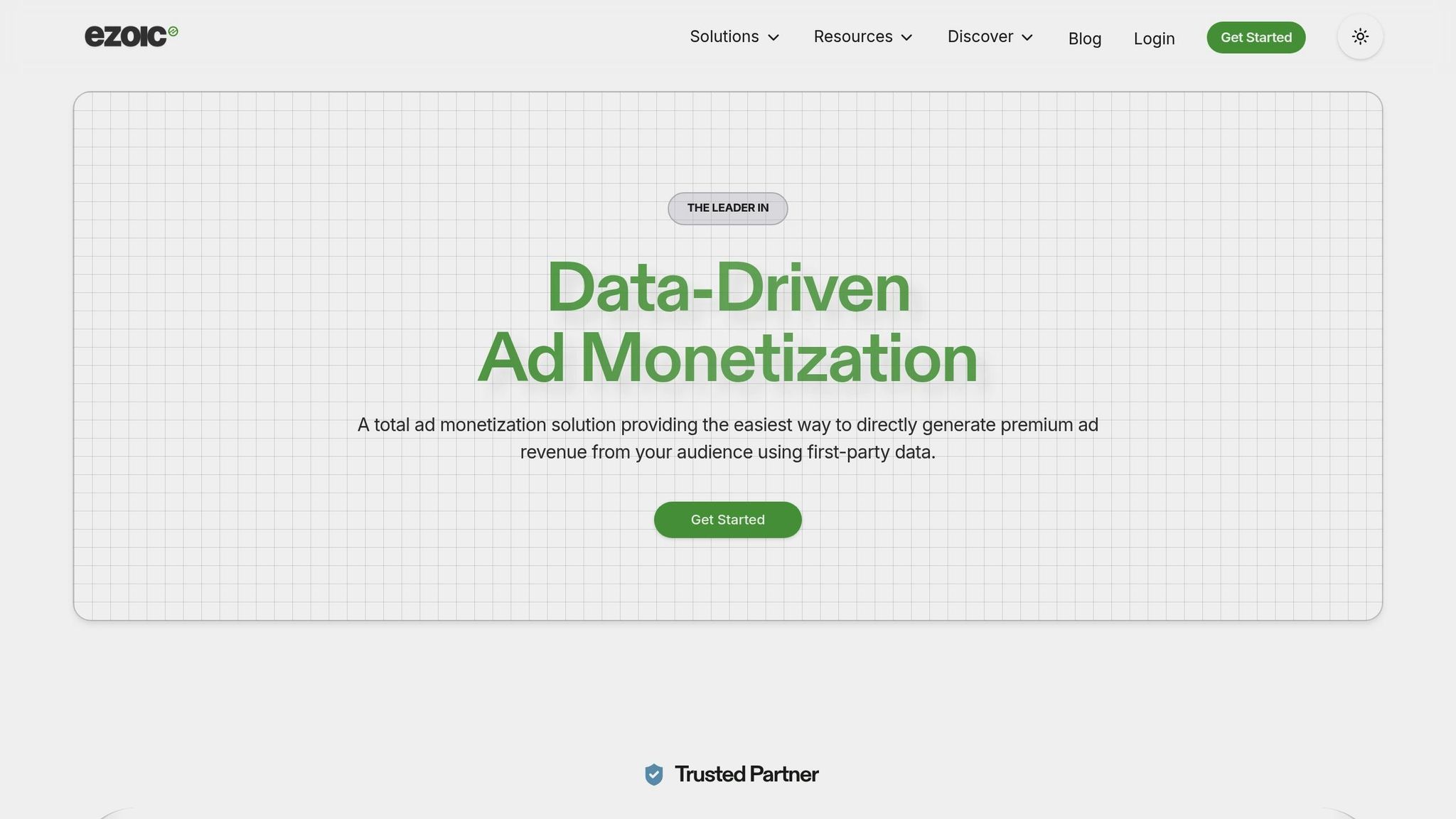
Ezoic is an AI-powered platform designed to optimize ad placements and boost revenue for publishers. It’s particularly appealing to smaller publishers looking for better earnings through machine learning.
Revenue Potential
Ezoic offers a wide range of earning possibilities, with EPMV (Earnings Per Mille Visitors) varying by niche and optimization level. For example, Money Builders reported an EPMV of $12.19, Owl Banking earned $7.50, and Niche Pursuits saw $16.63. On average, publishers with access to Ezoic’s full ad inventory can expect EPMVs between $12–18.
Earnings can start as low as $3 per 1,000 pageviews for newer sites, but well-optimized, premium niche sites can earn $50–60 per thousand views. With full optimization, publishers may eventually achieve $40–60 per 1,000 pageviews. Top-performing niches on Ezoic include Legal, Finance, Dating, Travel, Auto, Education, and Real Estate.
Traffic Requirements
One of Ezoic’s standout features is its inclusivity - it’s open to publishers of all sizes. There are no minimum traffic requirements, making it accessible to both new websites and seasoned publishers. For sites with fewer than 10,000 monthly pageviews, Ezoic offers the "Access Now" program, tailored to help smaller publishers get started.
Payout Structure
Ezoic’s payout system is flexible. Publishers can opt for an ad-funded model, where Ezoic displays some of its own ads to cover costs, or choose a 10% revenue share model. Payments are made monthly, ensuring a steady income stream.
Platform Features
Ezoic uses AI to test and refine ad placements, increasing both revenue and user experience. Its ezID feature boosts ad rates by +41% for identified visitors and +13% for others. Additional tools like the Site Speed Accelerator, Ezoic Leap, Big Data Analytics, Layout Tester, and Ad Tester enhance site performance and design testing. Integration with Google Ad Exchange and header bidding further expands monetization opportunities.
The platform’s self-serve dashboard gives publishers more control over their monetization metrics. Ezoic has earned a 4.4/5 rating on Software Advice, reflecting its strong reputation among users.
"Ezoic offers an ad management platform that makes it easy to monetize your website. Their platform offers many ways to control what/how many ads are displayed." - Christina, Verified reviewer, Writing and Editing
Next, we’ll take a closer look at how Ezoic’s flexible model compares to other platforms.
sbb-itb-957fd63
4. Mediavine
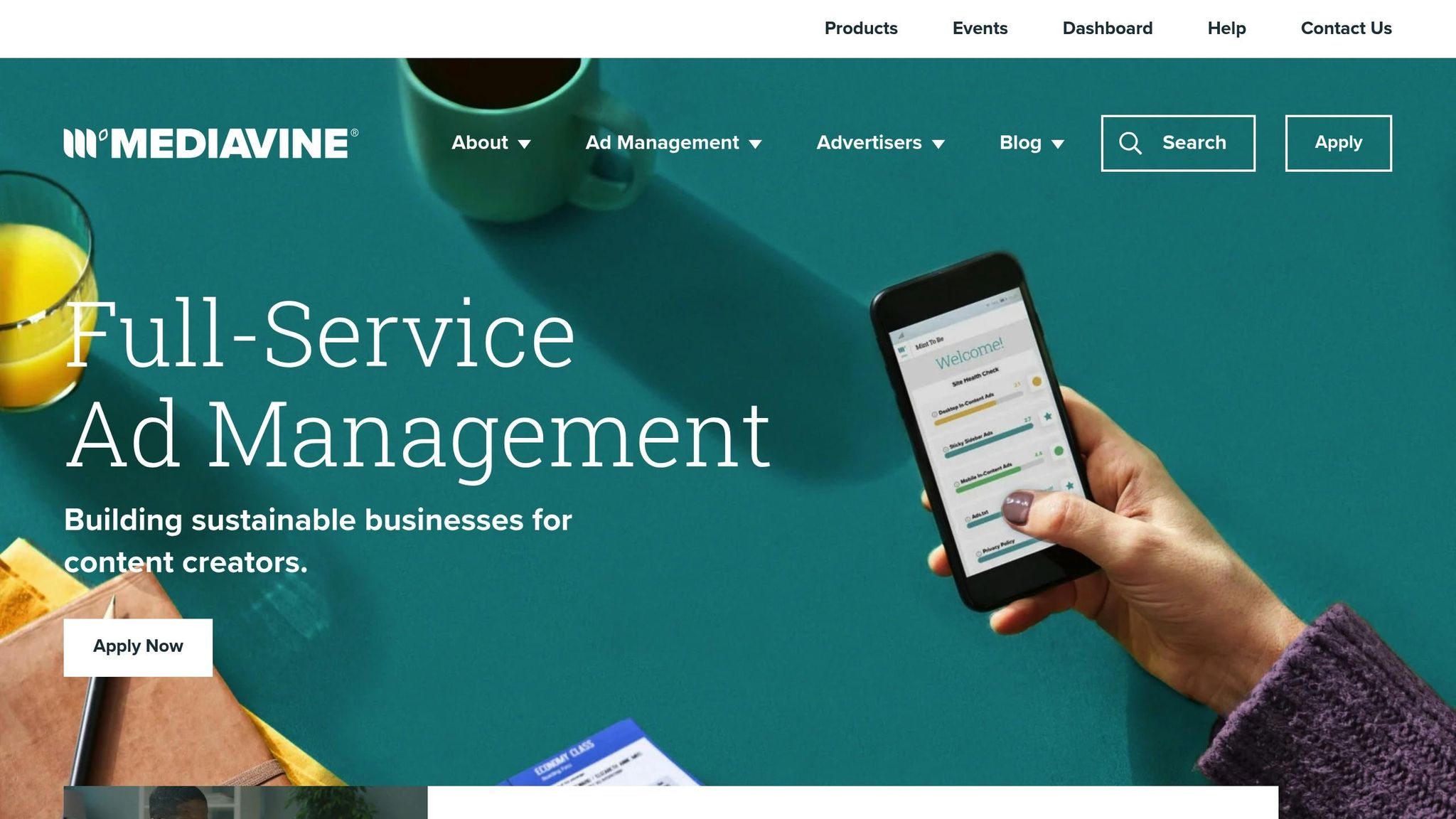
Mediavine is a premium ad management platform specifically designed for established content creators. What sets it apart is its focus on balancing high earnings with a seamless user experience. Founded by content creators themselves, Mediavine reflects the industry's shift toward prioritizing quality and performance over older, less refined models.
Traffic Requirements
Mediavine has high standards for entry, aligning with its premium reputation. To qualify for its main program, a website needs at least 50,000 monthly sessions. On average, about 75 to 100 websites apply daily, but only a small fraction make the cut.
For content creators who aren’t quite there yet, Mediavine offers an alternative: Journey by Mediavine. This program is open to sites with a minimum of 10,000 monthly sessions. This tiered system allows smaller publishers to grow within the Mediavine ecosystem before advancing to the main platform.
| Platform | Minimum Traffic Requirement |
|---|---|
| Mediavine | 50,000 sessions |
| Journey by Mediavine | 10,000 sessions |
Once traffic requirements are met, the next big question revolves around the platform's revenue potential.
Revenue Potential
Earnings with Mediavine can vary widely, depending on factors like niche and audience demographics. For example, publishers using Journey by Mediavine report an average RPM of $11.15, though some have seen RPMs climb above $30. Mediavine’s super auction system plays a key role here, as it allows multiple ad formats to compete for the same ad space, driving up bids and, consequently, revenue per thousand impressions.
Payout Structure
Mediavine uses a 75/25 revenue-sharing model, where publishers keep 75% of their monthly ad revenue. Over time, loyalty bonuses can increase this share to 80% after five years, with a 1% bonus added annually (capped at 5%). Publishers with sites generating 5 million ad impressions in 30 days can qualify for the 80% revenue share immediately. For smaller publishers in the Journey program, the revenue share starts at 70%.
Payments follow a Net 65 schedule, meaning earnings are paid out 65 days after the end of the month. While this extended payment cycle might pose challenges for cash flow, it’s a standard practice among premium ad networks.
Beyond revenue-sharing terms, Mediavine offers a variety of ad formats to help publishers maximize their earnings.
Platform Features
Mediavine provides a wide range of ad formats, including display, native, and video ads, all optimized for performance across devices. The platform adheres to IAB standards and surpasses Coalition for Better Ads guidelines, ensuring a smooth and user-friendly ad experience.
Some standout features include:
- Ad Refresh: Boosts revenue by reloading ads based on user engagement.
- Contextual and Device Targeting: Ensures ads are relevant to the audience.
- Innovative Formats: Interstitial ads, for instance, boast over 80% viewability and a 7% click-through rate.
Mediavine reaches 125 million unique visitors every month, offering publishers access to a vast pool of advertisers. The platform has also reduced in-content ad density by 54%, improving user experience without sacrificing revenue. Other features include universal video players for both desktop and mobile, sticky sidebar units, and high-performing 300×250 ad units, giving publishers diverse ways to monetize their content.
"Mediavine was founded by content creators, for content creators. Our goal is to provide your readers with the best possible user experience and you with maximum earnings, all with full transparency." - Mediavine
With its focus on continuous improvement, Mediavine ensures that publishers benefit from ongoing optimizations without needing to lift a finger.
5. Media.net
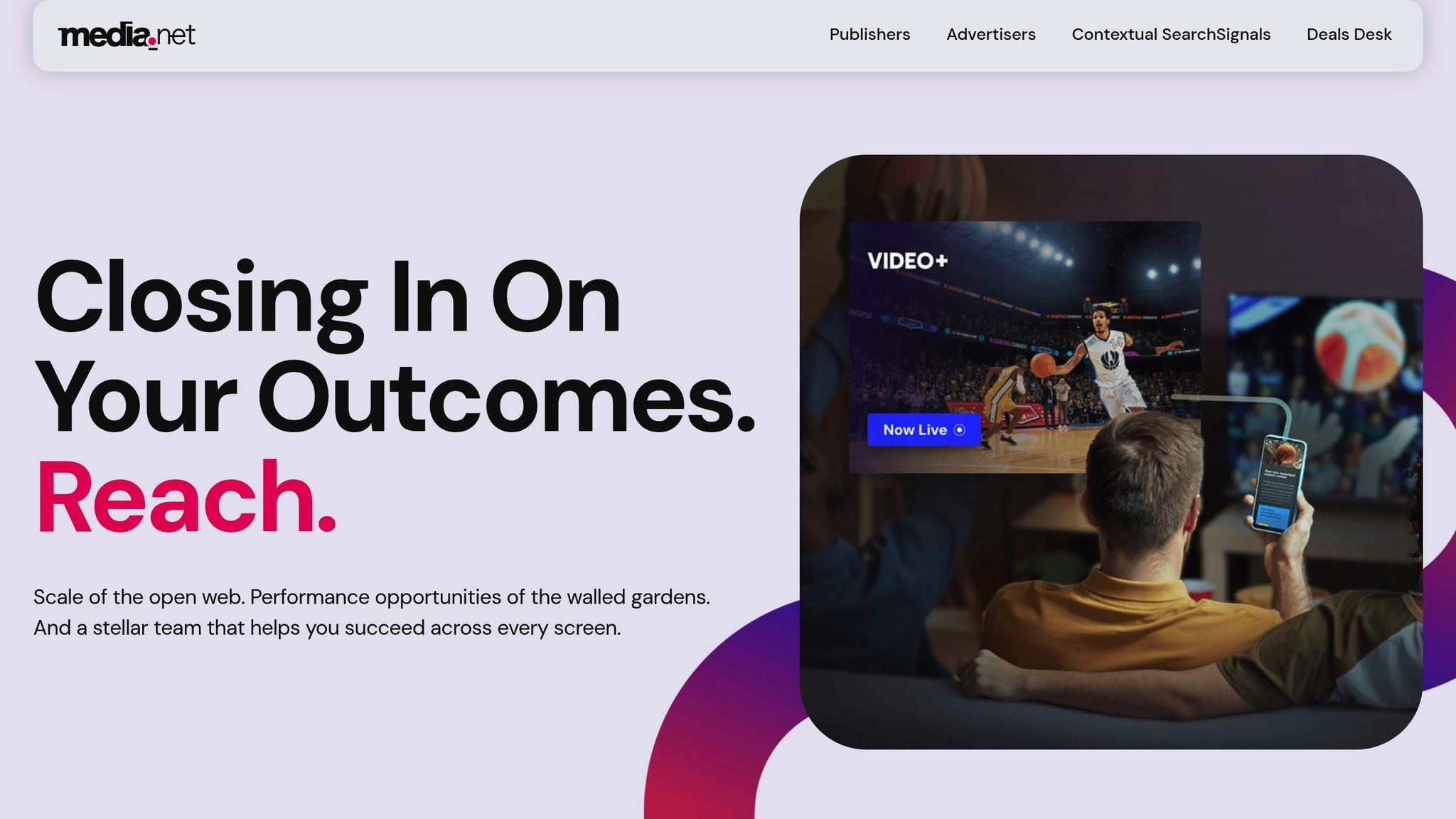
Media.net is a contextual ad network powered by Yahoo and Bing, focusing on high-quality websites and tier-1 traffic from countries like the United States, Canada, and the United Kingdom. It specializes in native ads that integrate seamlessly into website content, creating a smooth user experience.
Traffic Requirements
Unlike some networks with strict visitor minimums, Media.net places more emphasis on quality content and tier-1 traffic. While specific audience numbers aren't disclosed, publishers generally need a steady, high-quality monthly audience. As an invitation-only network, Media.net may decline sites that don't meet its standards.
Revenue Potential
Publishers can expect CPM rates ranging from $1.00 to $1.25, with some achieving up to $5.00 per 1,000 views.
Mark McShane, Founder of Cupid PR, shared his positive experience with Media.net:
"I use Media.net for contextual ads, which work well for my US and Canadian traffic. Powered by the Yahoo Bing Network, Media.net's ads are highly relevant to the content on my sites and get higher engagement and click-through rates. The network's competitive CPM and sleek and customizable ad format make it a good alternative to Google AdSense."
Ranked as the 5th-7th largest SSP for publishers targeting US and European audiences, Media.net is particularly lucrative for bloggers with substantial US traffic in niches like technology, finance, or legal services. These niches often see higher CPC rates, making the platform a profitable option.
Payout Structure
Media.net follows a Net-30 payment schedule, meaning payments are processed 30 days after the end of the month when earnings are generated.
Here’s a quick look at the payment options and their minimum thresholds:
| Payment Method | Minimum Threshold |
|---|---|
| PayPal | $100 |
| Wire Transfer | $500 |
| Payoneer | $100 |
Publishers must meet these thresholds to receive payments. While US-based users can opt for direct bank transfers, international users often rely on Payoneer for payouts.
Platform Features
Media.net stands out for its advanced contextual advertising technology and personalized optimization support. Serving millions of ad impressions daily across over 500,000 websites, the platform connects publishers to a vast pool of advertisers through the Yahoo Bing Network.
Some of its standout features include:
- Customizable Ad Formats: Ads can be tailored to match a website’s design, ensuring they blend naturally with the content.
- Dedicated Account Support: Publishers benefit from hands-on assistance to optimize ad layouts, a feature that sets Media.net apart from fully automated networks.
Additionally, Media.net is known for its responsive support team and lenient approach to account management. Unlike networks infamous for abrupt account suspensions, Media.net is more understanding, provided the traffic is genuine and high quality. The focus on native ad placement not only enhances user experience but also maintains the visual appeal of websites while generating revenue.
Platform Advantages and Disadvantages
Every platform caters to different publisher needs, balancing factors like accessibility, revenue potential, and support. Knowing these distinctions can help niche publishers find the best match for their specific circumstances and growth plans. Below is an overview of key platforms, followed by a comparison table for quick reference.
TinyAdz focuses on connecting niche publishers with highly targeted advertisers through specialized ad solutions. It has no minimum traffic requirements, making it ideal for smaller publishers. Its standout feature is personalized matchmaking for better ad relevance. However, being a newer platform, it has a smaller pool of advertisers.
Google AdSense is known for its ease of use and broad accessibility, making it a go-to for beginners. Publishers receive a 68% revenue share for display ads, and the platform has a $100 minimum payout threshold. While simple to use, its limited customer support and basic optimization tools may leave more advanced users wanting more.
Ezoic differentiates itself with AI-driven optimization and a robust feature set. It’s particularly appealing to publishers who want flexibility and data-driven insights. Christopher W., Managing Director, shared his experience:
"Ezoic rewards us much more than other ad services. We were really impressed with how they integrated across all of our websites."
Ezoic enjoys a 4.4/5 rating on GetApp and offers competitive rates with a low $20 payout minimum. However, users have noted a learning curve during setup and occasional impacts on site speed.
For publishers with higher traffic, Mediavine and Premium Publishers offer greater revenue opportunities but come with stricter entry requirements. Mediavine requires 50,000 sessions per month, while premium networks demand at least 100,000 page views for a first site. Both platforms offer hands-off management and excellent support, but Mediavine operates on a NET 65 payment schedule, and premium networks use NET 45 terms, which means longer payment cycles compared to platforms with NET 30 terms.
Media.net targets top-tier traffic from the United States, Canada, and the United Kingdom, offering CPM rates between $1.00 and $5.00 per 1,000 views. Its contextual ads blend seamlessly into content, and publishers benefit from dedicated account support. However, its invitation-only model and focus on high-quality traffic may exclude smaller or international publishers.
| Platform | Traffic Req. | Revenue Share | Min. Payout | Payment Term | Ideal For |
|---|---|---|---|---|---|
| TinyAdz | None | Not specified | Not specified | Not specified | Niche publishers seeking targeted ads |
| Google AdSense | None | 68% (display) | $100 | NET 30 | Beginners and simple setups |
| Ezoic | None | 90% (after 10% fee) | $20 | NET 30 | Publishers wanting AI optimization |
| Mediavine | 50k sessions/month | Not specified | $25 | NET 65 | Established sites with consistent traffic |
| Media.net | Quality tier-1 traffic | Not specified | $100 | NET 30 | Sites with US/UK/Canadian audiences |
For smaller publishers, platforms like TinyAdz, Google AdSense, or Ezoic offer easy entry with no traffic requirements. As your audience grows, premium platforms such as Mediavine or Media.net might provide better revenue potential for established sites. Starting with accessible options and scaling up as your traffic increases is often the best strategy.
Final Recommendations
AdSense continues to be a practical starting point for niche publishers in the U.S. in 2025, but it shouldn’t be the only monetization strategy you rely on. While around 38% of content sites still use AdSense as their primary income source, the digital landscape is shifting, and a more diversified approach is crucial.
The reality is stark: one in three publisher websites earns nothing. This highlights how critical it is to adopt an effective monetization strategy. Compounding this challenge, policy bans hit an all-time high in 2024, with 1.4 million account suspensions. These trends emphasize the need for careful planning and adaptability.
For new publishers with limited traffic, starting with platforms that have no minimum requirements is a smart move. AdSense and Ezoic are good examples. Ezoic, in particular, offers AI-driven ad optimization and a 90% revenue share (after a 10% fee), which can often outperform basic AdSense setups.
If your site attracts 10,000 to 50,000 monthly visitors, consider upgrading to premium solutions like Journey by Mediavine. These platforms provide access to higher-quality ads and can significantly boost revenue.
Diversification is more than a good idea - it’s vital. Static banner ads are becoming less effective, with non-video display ads projected to drop from 54% of programmatic ad spending in 2020 to just 36.2% by 2026. Many publishers are combining traditional ad networks with affiliate marketing, a channel expected to surpass $16 billion in spending by 2028.
For those targeting U.S. audiences, TinyAdz is worth exploring. This platform connects publishers with highly targeted advertisers and has no minimum traffic requirements, making it a great complement to larger ad networks. Its personalized approach can help fill revenue gaps and enhance overall earnings.
To protect your income and adapt to changes, test multiple platforms to compare performance. Keep in mind that most networks prioritize quality content, originality, and traffic from English-speaking regions for approval. Focus on creating content that resonates with your audience, then layer in monetization strategies that align with your goals.
Begin with accessible platforms like AdSense or TinyAdz, and as your traffic grows, expand and diversify your revenue streams. This balanced approach can help you build a sustainable and resilient publishing business.
FAQs
What are the advantages of using platforms like Ezoic or Mediavine instead of Google AdSense for monetizing your website?
Platforms like Ezoic and Mediavine offer publishers the opportunity to earn more ad revenue compared to Google AdSense. By leveraging advanced optimization tools and machine learning, these platforms fine-tune ad performance, often leading to higher earnings. They also provide greater flexibility with ad placement and design, which can help improve the user experience on your site.
One standout advantage is their focus on high-traffic websites. While Google AdSense is a great starting point due to its low entry barriers, Ezoic and Mediavine cater to more established publishers looking to scale their revenue. If your site consistently pulls in a significant audience, these platforms can be a strategic way to increase ROI and take your monetization efforts to the next level.
What are the best ways for smaller publishers to diversify their revenue streams and boost earnings?
Smaller publishers have plenty of ways to expand their income by tapping into strategies that align with their audience's interests. Some effective options include affiliate marketing, direct ad sales, sponsored emails, and paid subscriptions. Additionally, creating digital products like eBooks, exclusive content, or online courses can open up new revenue streams.
Social media can also play a big role - whether through influencer marketing or promoting premium offerings. By blending these approaches, publishers can avoid depending too heavily on one income source, creating a steadier and more reliable financial foundation.
What should publishers consider before switching from AdSense to a premium ad network?
When thinking about switching from AdSense to a premium ad network, it’s important to weigh a few critical factors to make sure the move supports your goals and fits your audience.
Start by looking at where your audience is located. Many premium ad networks tend to favor traffic from regions like the United States, Canada, Australia, and the United Kingdom. If a large portion of your visitors comes from these areas, it could mean better earning potential. Next, check the network’s approval criteria. Some require a minimum number of daily visitors or enforce strict content quality standards, which might influence whether your site qualifies. Also, take a close look at potential earnings - compare CPM rates and see how the network’s ad formats and customization options align with your site’s layout and user experience.
At the end of the day, the right decision depends on your audience, the type of content you create, and your revenue goals. Carefully evaluate these factors to ensure the transition boosts your monetization efforts.
